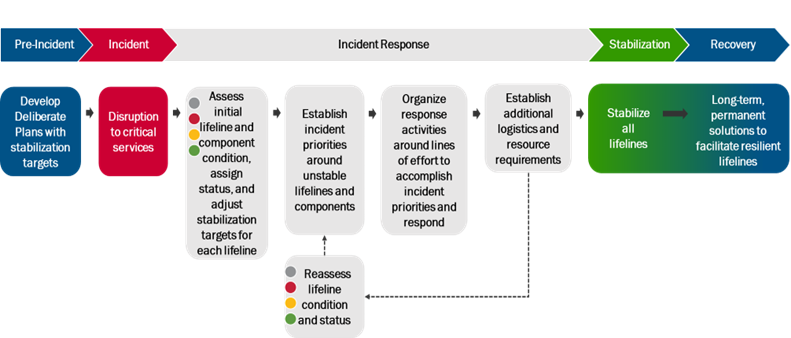FEMA introduced the Community Lifelines concept in the fourth edition of the National Response Framework issued in October 2019. This concept is explained further in the Community Lifelines Toolkit published in August 2020. The Community Lifelines concept provides a comprehensive, repeatable construct to enable rapid characterization and stabilization of an incident, minimize further cascading impacts, and chart an effective and efficient path to incident response and community recovery. Various aspects of this approach can be used to inform the chemical incident consequence management planning and decision framework as described above.
The Community Lifelines construct uses a step-by-step process and built-in tools for assessing the condition of lifelines, defining stabilization goals, and developing lines of effort (LOEs) to guide specific response actions. The four major steps that comprise this process are:
- Assess lifeline condition by component/subcomponent
- Establish stabilization targets
- Develop Lines of Effort (LOEs) and apply to Incident Action Plans (IAPs)
- Develop recovery outcomes

Within the overall Community Lifelines construct, the HAZMAT Lifeline is most directly applicable to chemical incident consequence management. The HAZMAT Lifeline provides a means for identifying, prioritizing, and addressing HAZMAT threats and impacts to public health, the environment, and/or critical infrastructure operations.
Emergency managers at various jurisdictional levels often utilize Community Lifelines to inform pre- and post-incident planning products and processes, including pre-identified stabilization targets for each lifeline, including the HAZMAT Lifeline. During an incident, pre-identified stabilization targets are re- assessed and updated based on actual lifeline impacts and stabilization projections related to a realized incident. Stabilization targets, in turn, inform planning and drive key leadership decisions and prioritization of response resources and actions, including the development of strategies, operational priorities, and objectives. Generic stabilization targets for the HAZMAT Lifeline may include the following:
- All contaminated areas/sites are identified and secured from unauthorized entry and egress;
- Decontamination and waste management plans have been developed for areas/sites affected as well as the decontamination of authorized personnel conducting response operations;
- Sampling and analysis methods are determined and operations are conducted by qualified teams and personnel to determine achievement of designated clearance levels; and
- Clearance levels are established to inform the re-occupancy of impacted facilities.
LOEs are specific mission-sets required to stabilize lifelines. They provide a useful structure for visualizing and prioritizing tasks to reach individual stabilization goals. Examples of generic LOEs for the HAZMAT Lifeline may include the following:
- Assessment of/reporting on contaminated facilities, materials, and equipment;
- Health and safety of site worker and responder personnel;
- Decontamination of facilities, materials, and equipment;
- HAZMAT waste management; and
- Area/site-specific re-occupation clearance.
Figure 3 provides an example of example of applying a “clearance” LOE and supporting tasks to achieve a defined end state using the HAZMAT Lifeline construct.

When all lifelines are stabilized, including the HAZMAT Lifeline, the mission focus shifts to a primary focus on recovery outcomes, although response and recovery efforts occur simultaneously throughout the incident. A community’s long-term recovery needs will vary depending on the scenario, context, and location of the chemical HAZMAT incident, as well as the incident’s impacts on the local population, critical infrastructure, and the economy. With the immediate hazard addressed during the response, recovery planning for chemical incident consequence management focuses on key actions needed to achieve the following:
- Continue to assess and protect human health and safety in the areas impacted by the incident;
- Restore/rebuild and/or re-occupy residential areas and critical infrastructure facilities and associated services;
- Mitigate further disruption of and rejuvenate the economy; and
- Continue to monitor and minimize further damage to the environment and complete the safe disposal of HAZMAT.


